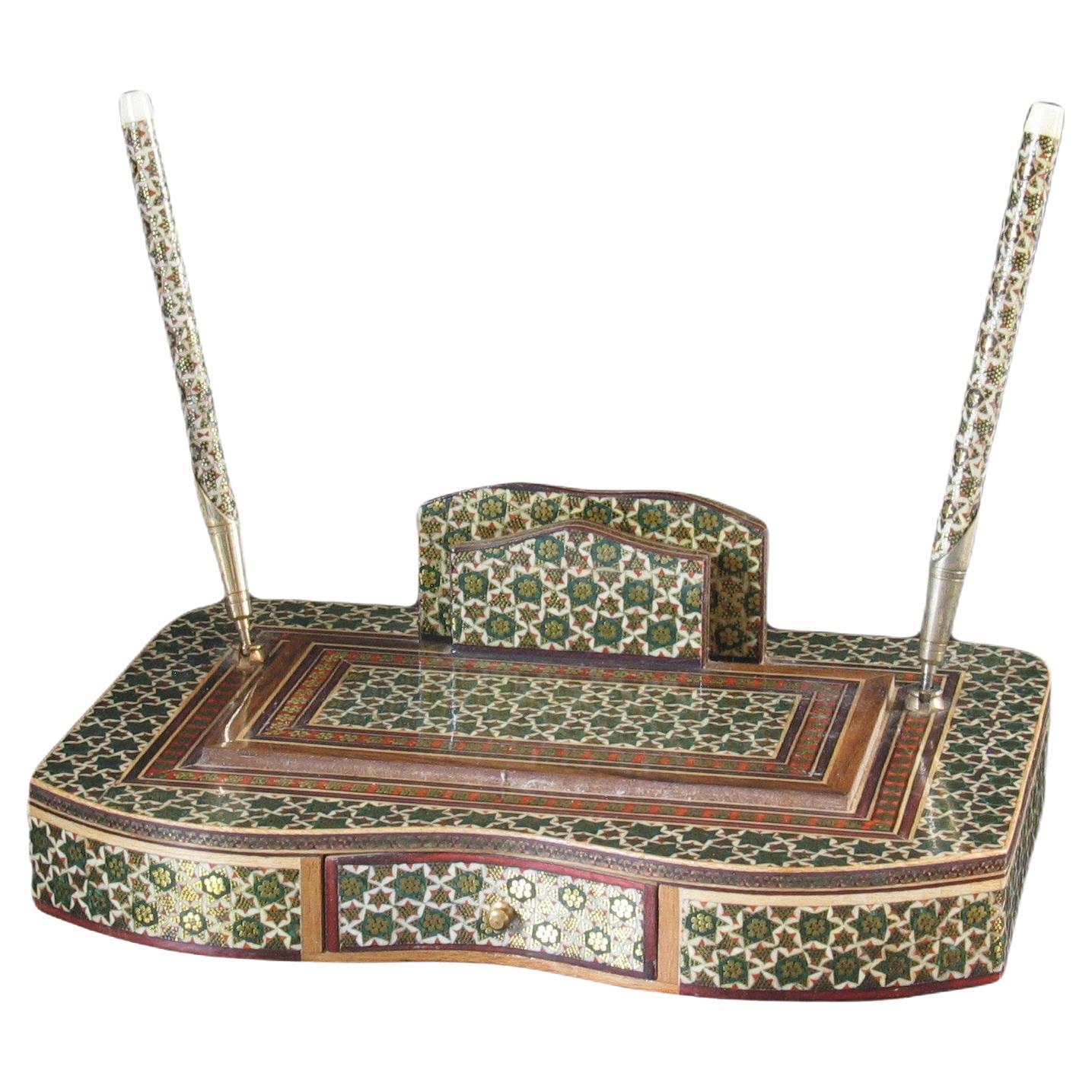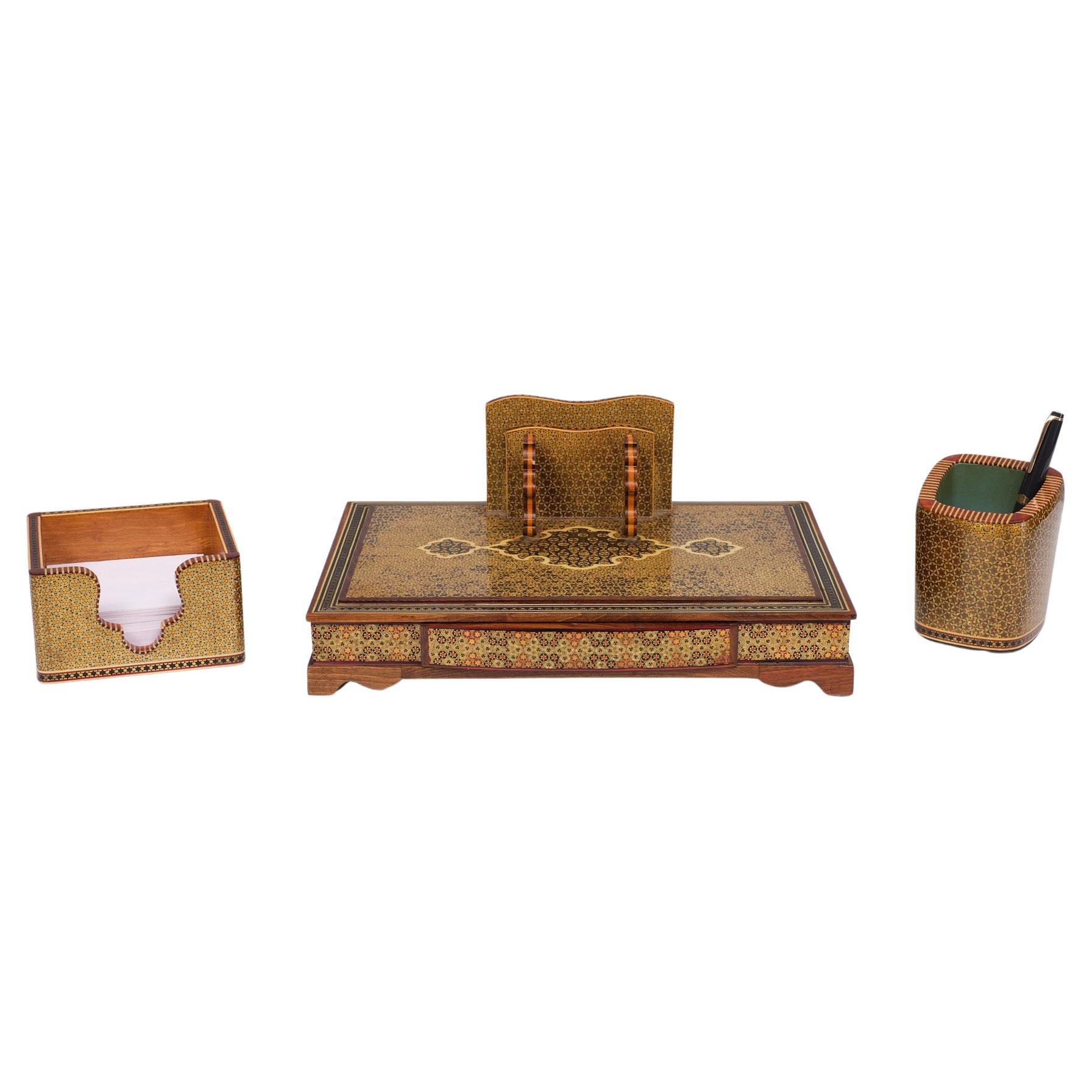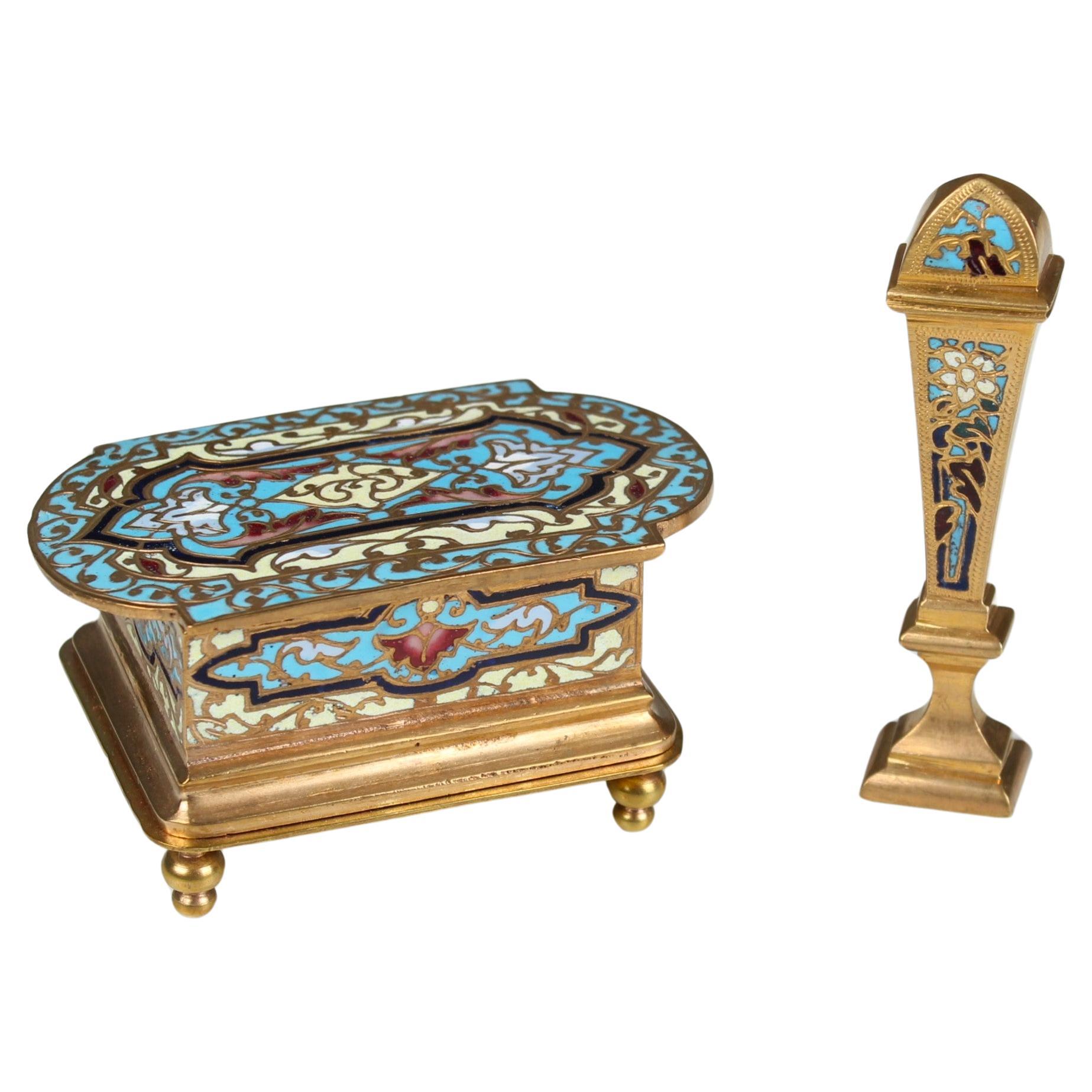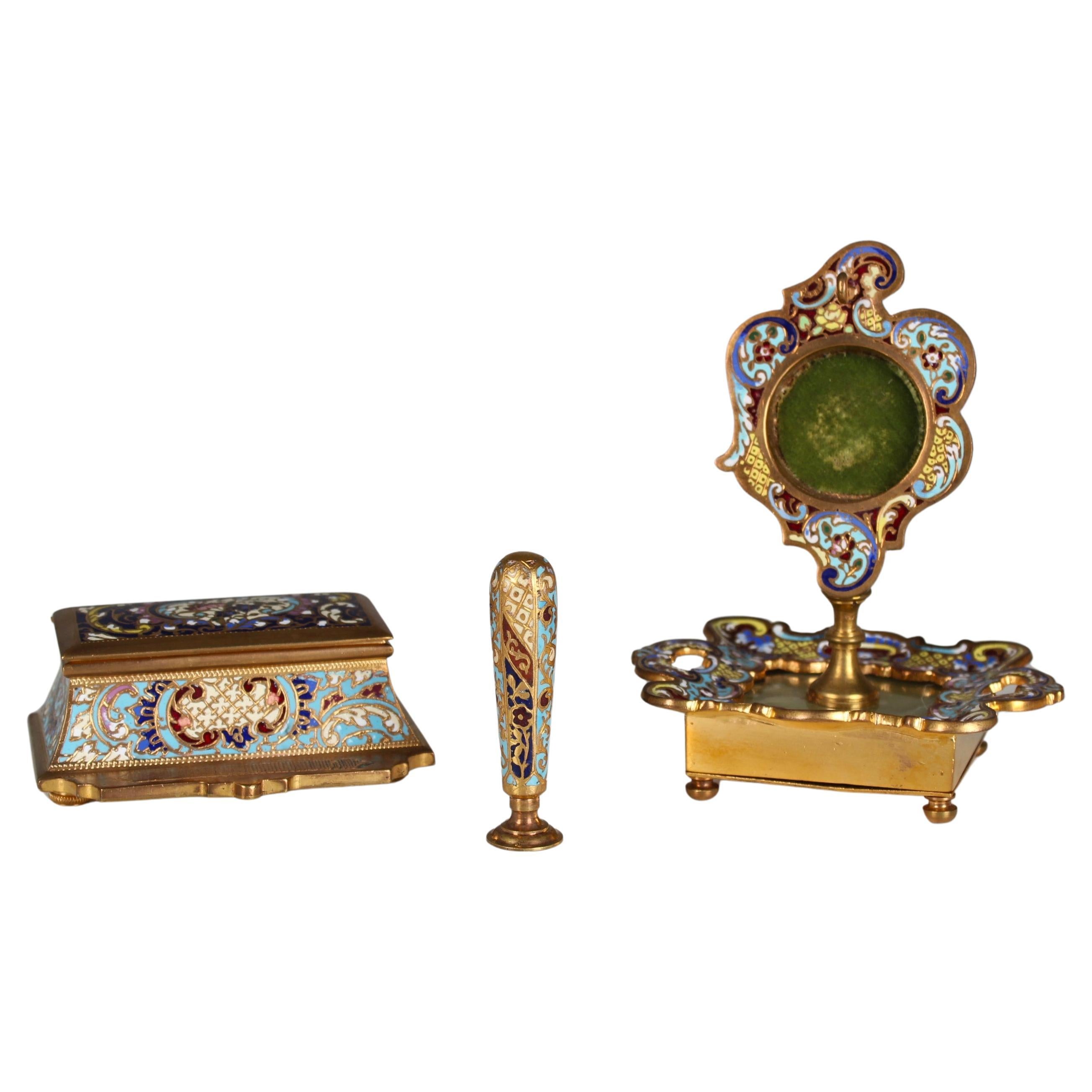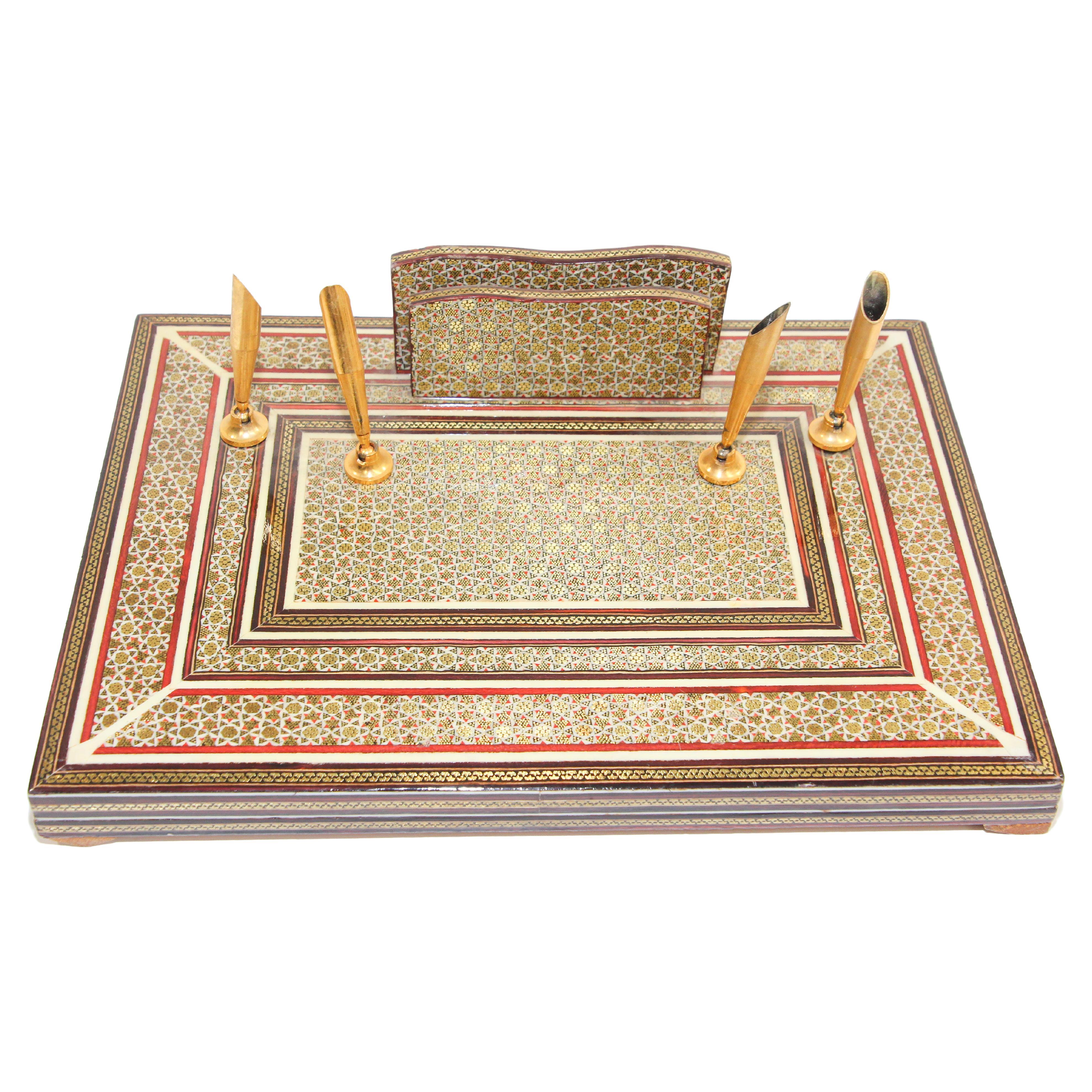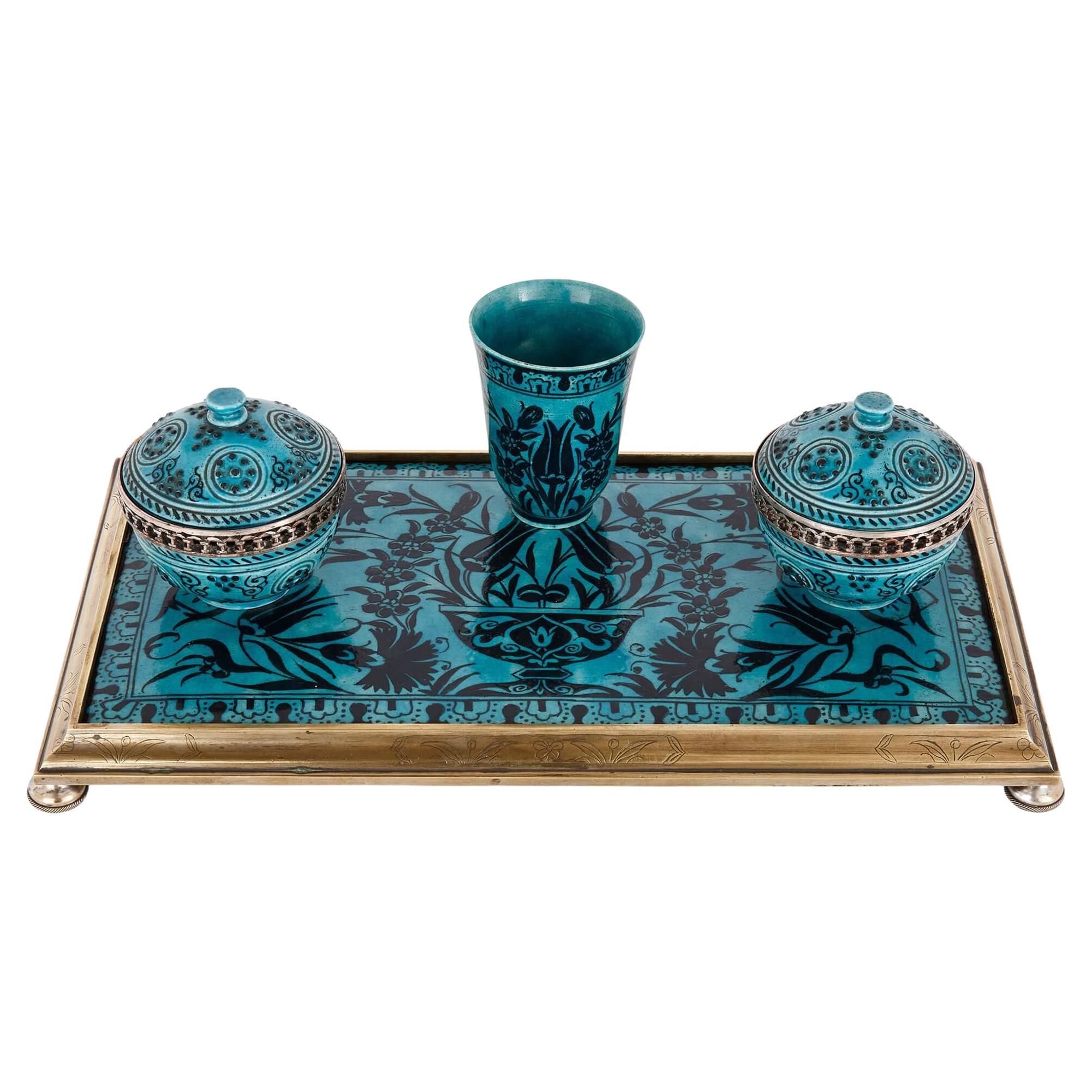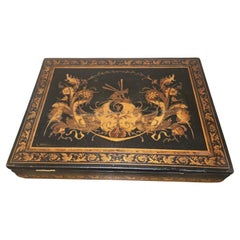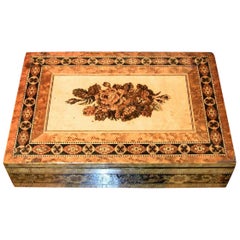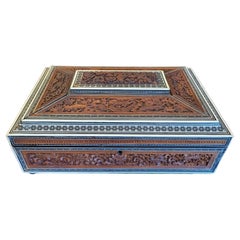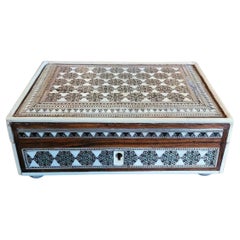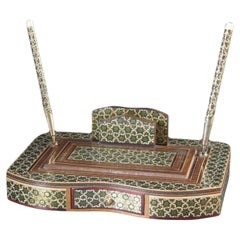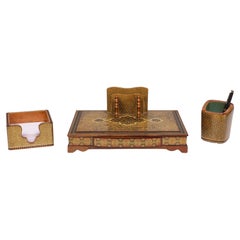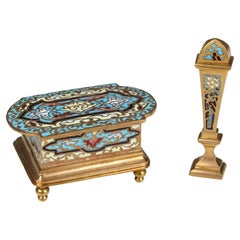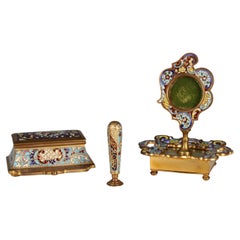Items Similar to Persian Desk Set with Khatam Mosaic
Want more images or videos?
Request additional images or videos from the seller
1 of 10
Persian Desk Set with Khatam Mosaic
$470per set
£356.38per set
€408.89per set
CA$668.75per set
A$725.45per set
CHF 381.48per set
MX$8,827.20per set
NOK 4,769.11per set
SEK 4,497.86per set
DKK 3,052.89per set
About the Item
PRESENTING A LOVELY Hand-painted Persian Desk Set with Khatam Mosaic.
Pair of items in the Set:
(1) Hand-painted Bone Plaque in Khatam Mosaic Frame, and
(2) Desk Companion Stand with brass pen holders, Stationery Holder and hand-painted Bone Plaque in Khatam Mosaic.
The framed plaque features a ‘Polo’ scene with 3 figures in tribal dress on horseback with polo sticks and ball, probably made circa 1960. Classic vintage Khatam mosaic. The bone panel in the frame, is beautifully painted and matted with hand painted Islamic style borders.
The desk stand plaque features a ‘Hunting” scene, with 2 riders in tribal dress, one with bow and arrow and a pair of animals (probably deer). Classic contemporary Khatam mosaic. Sits on 4 triangular platform feet. The pen holders are brass and are on a swivel ball hinge. Made in 2006 as noted on the base.
Note: The 2 gold pens, seen in the photos with the desk stand, are not included.
“Khātam (Persian: خاتم) is a Persian version of marquetry, art forms made by decorating the surface of wooden articles with delicate pieces of wood, bone and metal precisely-cut geometrical shapes. Khatam is also the capital of Khatam County in Iran. Khatam kari (Persian: خاتمکاری) is the art of crafting a Khatam. Common materials used in the construction of inlaid articles are gold, silver, brass, aluminum and twisted wire.
Designing of inlaid articles is a highly elaborate process. In each cubic centimeter of inlaid work, up to approximately 250 pieces of metal, bone, ivory and different kinds of wood are laid side by side, glued together in stages, smoothed, oiled and polished. Inlaid articles in the Safavid era took on a special significance as artists created their precious artworks. Woods used include betel, walnut, cypress and pine. These works include doors and windows, mirror frames, Quran boxes, inlaid boxes, pen and penholders, lanterns and shrines“
Provenance: Bought from an Antique Market in London.
Dimensions: (1) Frame: 9.75 in wide x 7 in high. Bone Panel: 5 in wide x 2.5 in high
(2) Desk Stand: 8 in Wide, 6 in Deep and 3.5 in tall
Condition: Both are in very good original condition. Some very minor repairs to the bottom edging of the frame but not significant or noticeable.
- Dimensions:Height: 3.5 in (8.89 cm)Width: 8 in (20.32 cm)Depth: 6 in (15.24 cm)
- Sold As:Set of 2
- Style:Islamic (In the Style Of)
- Materials and Techniques:
- Place of Origin:
- Period:
- Date of Manufacture:1960
- Condition:Repaired: Some very minor repairs to the bottom edging of the frame but not significant or noticeable. Wear consistent with age and use.
- Seller Location:Dallas, TX
- Reference Number:1stDibs: LU3978137803732
About the Seller
4.9
Gold Seller
Premium sellers maintaining a 4.3+ rating and 24-hour response times
Established in 2015
1stDibs seller since 2018
395 sales on 1stDibs
Typical response time: <1 hour
- ShippingRetrieving quote...Shipping from: Dallas, TX
- Return Policy
Authenticity Guarantee
In the unlikely event there’s an issue with an item’s authenticity, contact us within 1 year for a full refund. DetailsMoney-Back Guarantee
If your item is not as described, is damaged in transit, or does not arrive, contact us within 7 days for a full refund. Details24-Hour Cancellation
You have a 24-hour grace period in which to reconsider your purchase, with no questions asked.Vetted Professional Sellers
Our world-class sellers must adhere to strict standards for service and quality, maintaining the integrity of our listings.Price-Match Guarantee
If you find that a seller listed the same item for a lower price elsewhere, we’ll match it.Trusted Global Delivery
Our best-in-class carrier network provides specialized shipping options worldwide, including custom delivery.More From This Seller
View All19C British Tunbridgeware Micro-mosaic Lap Desk - RARE
Located in Dallas, TX
PRESENTING an ABSOLUTELY GORGEOUS and EXTREMELY UNIQUE and RARE 19C British Tunbridgeware Micromosaic Lap Desk.
This lap desk is unlike any of it’s kind we have seen before.
From c...
Category
Antique Mid-19th Century English High Victorian Decorative Boxes
Materials
Boxwood, Maple, Walnut
19C English Tunbridgeware Tabletop Stationary Box, Micro Mosaic
By Tunbridge Ware
Located in Dallas, TX
Stunning little 19th century tabletop stationary box made of micro-mosaic.
Made in Britain, circa 1870, in Tunbridge Wells, hence these type of works are called Tunbridgeware!
...
Category
Antique Late 19th Century English High Victorian Decorative Boxes
Materials
Boxwood, Ebony, Walnut, Burl
19C Anglo Indian Highly Carved Sadeli Mosaic Sarcophagus Sewing Box
Located in Dallas, TX
PRESENTING A GORGEOUS 19C Anglo Indian Highly Carved Sadeli Mosaic Sarcophagus Sewing Box.
Made in Bombay, India circa 1860-80.
Box made of sandalwood with highly carved teak wood reliefs and panels on all sides.
Edged with bone and ebony veneers and glorious sadeli mosaic, made from tiny pieces of faux ivory, pewter, green semi-precious stone.
The box is in a sarcophagus form with domed lid.
The original brass carry handles are on the sides.
The interior is in great condition and consists of a removeable mirror under the lid portion, with the original red velvet lining behind it.
The base is removeable and contains a number of lidded compartments.
6 of the interior lids on the base, are each inlaid with sadeli mosaic banding. The rest are also carved and chased.
The interior is fully complete with 7 lidded faux ivory/bone, thread canisters with sadeli domes and the original bone thimble.
The box sits on 4 brass ball or bun feet with the original velvet lining on the base.
Some minor repairs and losses, but this box is fully complete. This is ‘rare’ as many of these boxes have not survived in such condition!
Included in the sale are 2 photos that were in the box (under the base tray). Interestingly, one of them is a view of downtown Nassau, New Providence (Bermuda) from the early 20C and stamped on the rear. What a ‘journey’ this piece has made! Made in India … travelled to Bermuda, probably via Britain … back to Ireland (where we bought it) …. then to Texas!
These boxes were made by superb Indian craftsmen, specifically for sale to the ruling British elite. These types of boxes, carved padouk and sandalwood, (whilst beautiful and superbly crafted) were of a lesser quality, than the more profusely and intricately mosaic inlay, tortoiseshell and ivory boxes, made for the British ‘Upper Classes’ in the areas of Bombay and Vizagapatam. These type of boxes were much more affordable back in 1880 (and indeed today) and would probably have been bought by mid-level diplomats, civil servants or visitors.
Sewing boxes (in general), were in EVERY Victorian home in Britain in the 19th Century and like other boxes etc were ‘status symbols’ of your place in society! The more ornate the box, the more ‘Upper Class’ you were!
Of it’s type, this one, is one of the very higher quality one’s, than the norm!
SADELI MOSAIC: “Anglo Indian boxes were made in India for the English residents from the early part of the 18th century. They were brought back or sent back to England usually by the people who had commissioned them. From the beginning of the nineteenth century they were imported more commercially, although not in any significant numbers until the middle decades. They were very highly valued, especially the early ones, to the extent that the designs were copied on late 19th and early 20th century tins.
The ancient art of Sadeli Mosaic is said to have been introduced from Shiraz in Persia via Sind to Bombay, a long time before the Anglo Indian boxes were made. It was a technique, which required a high degree of skill and patience. It was executed very lavishly, in that the frequent cuts wasted a great amount of the precious materials used. The workmanship was however more than commensurable to the value of the materials.
Ivory, silver, pewter (or other metals), wood and horn were cut into faceted rods which were bound together to form geometric patterns. When the glue has set, the rods were sliced in transverse sections. This gave the maker a number of angled circular pieces in the original pattern. Several variations of patterns could be achieved by combining the materials in different ways. The ivory was sometimes dyed green to give an extra color.
The mosaic pieces in a combination of patterns, often separated by ivory, ebony, horn or silver stringing were used to veneer sandalwood boxes. In the early boxes, which date from the turn of the 18th to the 19th century, there are large panels of mosaic covering tops and sides of boxes. It took incredible skill to cover such large areas without any shakes or wavering of the pattern. The corners and joins on these boxes are impeccably matched.
The makers (reputed to be Persian) of Sadeli mosaic made in the first two decades of the 19th century displayed a total understanding of the qualities of the different materials they used. They combined substances, which can expand and contract according to atmospheric conditions with others, which are hard and unyielding. The result was a sharp definition of the lines and patterns, which made up the whole design.
On the early boxes the designs look deceptively simple. The fact is, they emerged from a culture, which had mastered geometry and understood how to generate a pattern from a set number of points. The patterns are so harmoniously combined that their incredible complexity is not immediately apparent.
The earliest Sadeli boxes...
Category
Antique 19th Century Indian Anglo-Indian Decorative Boxes
Materials
Bone, Sandalwood, Teak
19C Anglo Indian Bombay MOP Sadeli Mosaic Trinket Box
Located in Dallas, TX
PRESENTING a LOVELY 19C Anglo Indian Bombay MOP (Mother of Pearl) Sadeli Mosaic Trinket Box from circa 1875-85.
Gorgeously detailed and hand-crafted ‘sadeli mosaic’ inlay, from the Bombay Area, with deep greens with silver, pewter, mother of pearl, bone and ebony in geometric patterns.
The box case, is made of sandalwood but completely covered in MOP, bone, faux ivory, ebony and mosaic inlay.
Edged with faux ivory and banded with a different pattern of sadeli mosaic.
Some minor damage to the top (repair is obvious in pics) and ivorine replacements to some edging, but it still a BEAUTIFUL BOX and of real QUALITY!
The mosaic work is FABULOUS!
Box opens to reveal its original blue velvet lining.
It sits on 4 (recently added) silvered button feet.
SADELI MOSAIC: “Anglo Indian boxes were made in India for the English residents from the early part of the 18th century. They were brought back or sent back to England usually by the people who had commissioned them. From the beginning of the nineteenth century they were imported more commercially, although not in any significant numbers until the middle decades. They were very highly valued, especially the early ones, to the extent that the designs were copied on late 19th and early 20th century tins.
The ancient art of Sadeli Mosaic is said to have been introduced from Shiraz in Persia via Sind to Bombay, a long time before the Anglo Indian boxes were made. It was a technique, which required a high degree of skill and patience. It was executed very lavishly, in that the frequent cuts wasted a great amount of the precious materials used. The workmanship was however more than commensurable to the value of the materials.
Ivory, silver, pewter (or other metals), wood and horn were cut into faceted rods which were bound together to form geometric patterns. When the glue has set, the rods were sliced in transverse sections. This gave the maker a number of angled circular pieces in the original pattern. Several variations of patterns could be achieved by combining the materials in different ways. The ivory was sometimes dyed green to give an extra color.
The mosaic pieces in a combination of patterns, often separated by ivory, ebony, horn or silver stringing were used to veneer sandalwood boxes. In the early boxes, which date from the turn of the 18th to the 19th century, there are large panels of mosaic covering tops and sides of boxes. It took incredible skill to cover such large areas without any shakes or wavering of the pattern. The corners and joins on these boxes are impeccably matched.
The makers (reputed to be Persian) of Sadeli mosaic made in the first two decades of the 19th century displayed a total understanding of the qualities of the different materials they used. They combined substances, which can expand and contract according to atmospheric conditions with others, which are hard and unyielding. The result was a sharp definition of the lines and patterns, which made up the whole design.
On the early boxes the designs look deceptively simple. The fact is, they emerged from a culture, which had mastered geometry and understood how to generate a pattern from a set number of points. The patterns are so harmoniously combined that their incredible complexity is not immediately apparent.
The earliest Sadeli boxes...
Category
Antique Late 19th Century Indian Anglo-Indian Jewelry Boxes
Materials
Silver
19th Century Anglo Ceylonese Specimen Wood Desk Companion Tray
Located in Dallas, TX
Another stunning 19th century Anglo-Ceylonese piece.
Made circa 1880 in Ceylon (Now Sri Lanka) of Coromandel wood and specimen woods.
This is a simply gorgeous and quality item!! Tray made of various compartments with various high quality specimen wood lids, all edged and banded in chevrons of bone, silver or pewter and ebony.
The tray itself is made of expensive coromandel wood. There are two open sections on either side of the tray which have bone and hand-painted lac ends. The main tray sits onto a base made of coromandel wood with green baize lining.
This tray could have a number of practical uses, for keeping stationary, watches, jewelry, or thinking outside of the box, holding you remote controls and candy!!
We have a matching box also in our Inventory and for auction.
ANGLO-INDIAN AND CEYLONESE BOXES: Anglo Indian boxes were made in India for the English residents from the early part of the 18th century. They were brought back or sent back to England usually by the people who had commissioned them. From the beginning of the nineteenth century they were imported more commercially, although not in any significant numbers until the middle decades. They were very highly valued, especially the early ones, to the extent that the designs were copied on late 19th and early 20th century tins.
Anglo-indian Boxes normally consist of 3 main types:-
(1) Most of the best and highest quality Anglo-Indian boxes in the 18th and 19th Centuries were made in Vizagapatam, India, renowned for its exquisite craftsmanship in using ivory and tortoiseshell and lac decoration. These are referred to as ‘Vizagapatam Boxes...
Category
Antique Late 19th Century Sri Lankan British Colonial Decorative Boxes
Materials
Ebony, Wood
19C Anglo Ceylonese Lap Desk of Museum Quality
Located in Dallas, TX
Presenting an absolutely fantastic 19C Anglo Ceylonese lap desk of museum quality.
We can safely say that this is one of the finest lap desks we hav...
Category
Antique Early 19th Century Sri Lankan Anglo-Indian Decorative Boxes
Materials
Bone, Ebony, Sandalwood
You May Also Like
Persian Khatam Marquetry Pen and Letter Desk Set 20th Century
Located in Ottawa, Ontario
PERSIAN KHATAM MARQUETRY
PEN AND LETTER DESK SET
20th century
Khatam marquetry covered wooden
rectangular serpentine front base with drawer.
Letter holder with two brass tip pen res...
Category
Mid-20th Century Persian Islamic Desk Sets
Materials
Wood
Vintage 1950s Persian Khatam Pen and Letter Desk Set
Located in Den Haag, NL
Very nice Three piece desk set
The mosaic design work is gorgeous, using various color woods and other natural materials.
This wooden desk set pen h...
Category
Vintage 1950s Iraqi Islamic Desk Sets
Materials
Wood
Antique Cloisonné-Emaille Desk Set, Bronze Doré, France, Circa 1880
Located in Greven, DE
Exceptional Enameled Desk Set of a box and a seal stamp, France circa 1880.
Beautiful Cloisonné- enamel work in bold blue, turquoise, red and beige colours.
Measures:
Stamp- or matc...
Category
Antique Late 19th Century French Late Victorian Desk Sets
Materials
Brass, Enamel
Antique Cloisonné-Emaille Desk Set, Bronze Doré, France, Circa 1880
Located in Greven, DE
Exceptional Enameled Desk Set of a box, seal stamp and a pocket watch stand, France circa 1880.
Beautiful Cloisonné- enamel work in bold blue, turquoise, red and beige colours.
Meas...
Category
Antique Late 19th Century French Late Victorian Desk Sets
Materials
Brass, Enamel
VIntage Persian "khatam" Pen Holder
Located in Moreno Valley, CA
This is a vintage Persian style letter and penholder with 4 brass tips pen holder.
The wooden base is khatam inlaid micro mosaic.
It is solid and in very good condition for age.
...
Category
Mid-20th Century Asian Moorish Scholar's Objects
Materials
Wood
Iznik-Style Ceramic and Brass-Mounted Ink Stand
By Iznik Pottery
Located in London, GB
Iznik-style ceramic and brass-mounted ink stand
French, 19th Century
Height 10.5cm, width 34cm, depth 19cm
Revealing a vase and flowers contained in a border of repeating pattern-work, with two lidded inkwells flanking a central holder, this remarkable desk-piece is a very fine Iznik style inkstand, made in France in the late nineteenth century. Stylistically, it draws upon earlier Islamic...
Category
Antique 19th Century French Islamic Inkwells
Materials
Brass
